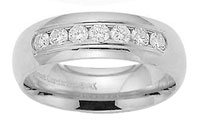Of the classic four C's of diamond grading (cut, clarity, color and carat weight) the hardest for buyers to get their minds around is cut. The weight of a diamond is a simple matter for a scale. Color becomes apparent when the gem in question is set alongside a grading set that shows the range of hues commonly found in diamonds; lighter than that one, darker than this one. Under a microscope, the tiny inclusions that interfere with a stone's clarity stand out like a blond hair on the suit coat of a man with a red-headed wife.
Cut is much more complex. A modern round brilliant diamond has 58 separate surfaces or facets, each of which has an ideal proportion and orientation to the others. Because of this complexity, there is not a clear-cut rating of cut to match that of color and clarity.
However, the ideal of a well-cut diamond is simple- One cut to guide light through it that produces the most brilliance and fire possible.
 Think of this analogy. Suppose you lived in the desert and wanted to heat a tank of water to do laundry. If you had a bunch of mirrors, you could set them around the tank, arranging them so that sunlight was reflected directly on the tank. Enough beams of light and you could have that water boiling merrily away. Think of this analogy. Suppose you lived in the desert and wanted to heat a tank of water to do laundry. If you had a bunch of mirrors, you could set them around the tank, arranging them so that sunlight was reflected directly on the tank. Enough beams of light and you could have that water boiling merrily away.
If, however, some of the mirrors slipped, sent light into a sandstone rock face or into the sand underfoot, the water may remain tepid. There are a lot of 'tepid' diamonds on the market, flat and lifeless.
To continue with the mirror analogy, the ideal cut for a brilliant diamond arranges those mirrors perfectly to bounce light from facet to facet and produce flashes of light as the stone is rotated.
A round brilliant that is cut to ill proportions might show a fish-eye-like ring inside, or a dark spot in the center of the stone, or other detracting flaws.
You might ask, if a diamond cut to modern proportions is so appealing, why aren't all diamonds cut this way? The answer is cost. When the cutter sizes up a rough diamond, he is looking to get as much value from it as possible. Often, the crystal will have inclusions (carbon spots, crystal feathers, and the like,) that would end up in the middle of a standard-cut brilliant, ruining the fire of the stone. To cut around these to reach the clear areas from which a brilliant cut can be made could require wasting a large portion of the stone. However, by fudging on the proportions, by, for example, cutting the gems a little wider and a little shorter, two or three so-so stones can be produced. As long as customers are willing to pay for such stones, and aren't willing to pay the difference to buy a diamond with ideal proportions, this method maximizes producer profit.

There are dozens of other 'fancy' cuts of diamonds, such as the rectangular emerald, the marquise (like a cat's eye), pear, and oval, all of which also have ideal proportions for maximum fire. However, larger stones in these styles are less popular and therefore not as prevalent in your local jewelry store. So what can you do to assure the diamond you're considering is well cut? Ask your jeweler to show you a well-cut stone. Note how the facets are symmetrical, the girdle (the outside edge) is neither fat nor knife-thin and uniform, how the proportion between the upper part and lower part of the diamond is roughly one to three. Most importantly, though, look at it face on. Does it fire?
For my money, I'd rather buy a smaller stone with excellent conformation than a larger one with goofy proportions. Regardless of what some in our bling bling world would have you believe, size and beauty are not the same thing. And proportion is the key. |